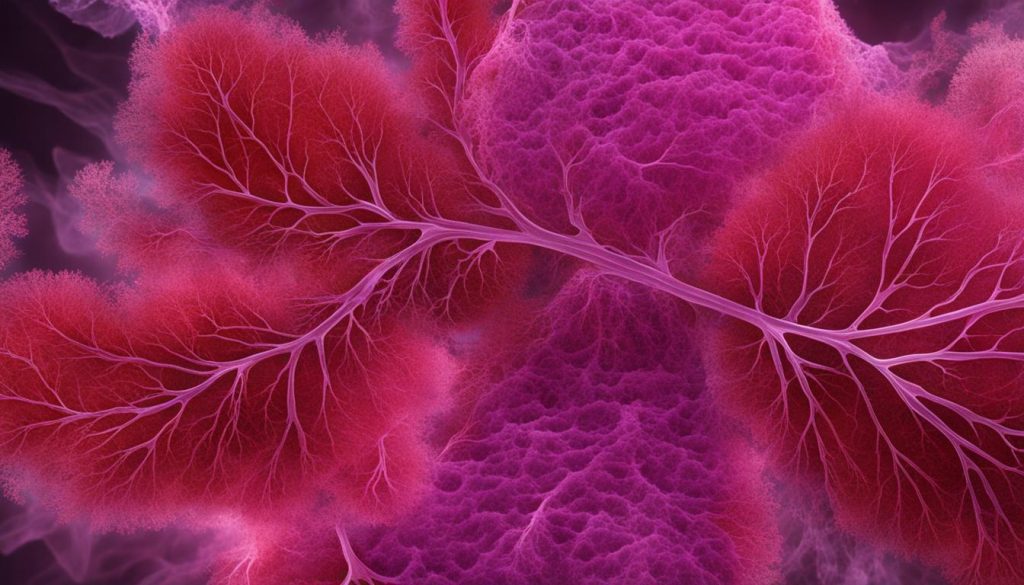Having a family history of breast cancer can be a cause for concern. You may be wondering what it means for your own risk of developing the disease. It’s important to understand that a history of breast cancer in your family does increase the risk, but it does not guarantee that you will develop breast cancer.
If you have a family history of breast cancer, especially in first-degree relatives such as your mother, sister, or daughter, the risk may be higher. The risk is also elevated if your affected relatives were diagnosed at a young age, under 50.
However, it’s crucial to note that most women with a family history of breast cancer will never develop the disease. The risk is relative, and there are several other factors that come into play.
If you are concerned about your risk due to a family history of breast cancer, it is recommended to seek guidance from a specialist breast or genetics clinic. They can assess your risk based on your family history and other factors, such as gene mutations, and provide appropriate recommendations for screening and prevention.
Guidelines for Referral and Assessment
When it comes to assessing the risk of breast cancer in individuals with a family history, UK guidelines provide valuable criteria for GPs to follow. These guidelines help identify individuals who may have an increased risk of breast cancer due to their familial background. By recognizing the signs, healthcare professionals can ensure that those at risk receive the necessary evaluation and support.
Specialist referral criteria play a crucial role in determining who should be assessed at a specialist breast or genetics clinic. These criteria include several key factors such as having a first-degree female relative diagnosed with breast cancer before the age of 40, a male relative with breast cancer at any age, or multiple first-degree relatives affected by breast cancer. Additionally, a combination of breast and ovarian cancer in close relatives, bilateral breast cancer, or certain specific cancer types in relatives can also warrant referral.
By adhering to these referral guidelines, healthcare providers can identify individuals who may benefit from further screening or genetic testing. Early detection and intervention are vital in managing breast cancer, and referral and assessment guidelines help ensure that those at increased risk receive the necessary care.
Breast Cancer Gene Mutations
Certain gene mutations, such as BRCA1 and BRCA2, can significantly increase the risk of developing breast cancer. These genes play a crucial role in regulating the growth and division of cells in the body. However, when these genes are mutated, they can disrupt their normal function, leading to uncontrolled cell growth and an increased risk of breast cancer. Other gene mutations, including TP53, PALB2, ATM, CHEK2, STK11, and PTEN, have also been associated with an increased risk of breast cancer.
It is important to note that while these gene mutations can increase the risk of breast cancer, most cases of breast cancer are not caused by inherited gene mutations. In fact, only about 5 to 10% of breast cancer cases are estimated to be linked to these specific mutations. The majority of breast cancer cases occur sporadically, without a known genetic cause.
Identifying individuals with these gene mutations can be crucial for their management and risk assessment. Genetic testing can help identify individuals who may be at a higher risk of developing breast cancer due to these gene mutations. This information can guide healthcare providers in implementing appropriate screening strategies and preventive measures to mitigate the risk and detect breast cancer at an early stage when it is more treatable.


Importance of Breast Cancer Risk Assessment
When it comes to breast cancer, early detection is key. That’s why breast cancer risk assessment plays a crucial role in identifying individuals who may be at a higher risk of developing the disease. By evaluating factors such as family history, gene mutations, and personal characteristics, healthcare professionals can determine an individual’s level of risk and implement appropriate screening and prevention strategies.
For those identified as having an increased risk, extra screening measures may be recommended. This can include more frequent mammograms or other imaging tests, which can help detect breast cancer at an early stage when it is more treatable. Surveillance protocols are in place to guide the screening and monitoring of individuals at higher risk, taking into account their personal and family history. Regular surveillance can provide peace of mind and ensure that any potential signs of breast cancer are detected promptly.
Extra Screening and Surveillance Protocols
Breast cancer risk assessment not only helps identify individuals who may benefit from extra screening but also provides healthcare professionals with valuable information for developing surveillance protocols. These protocols are personalized to the individual’s level of risk and help determine the appropriate frequency and type of screening. They take into consideration factors such as age, family history, and genetic mutations, allowing for a tailored approach to monitoring breast health.
By implementing these surveillance protocols, healthcare professionals can ensure that individuals at a higher risk of developing breast cancer receive the necessary care and attention. Regular screening can help detect any abnormalities or potential signs of breast cancer at an early stage, improving the chances of successful treatment and survival. Breast cancer risk assessment, along with the subsequent extra screening and surveillance protocols, is an essential tool in the fight against breast cancer.
The Link Between Family History and Breast Cancer Risk Perception
Studies have shown that family history of breast cancer can influence an individual’s perception of their own risk of developing the disease. Women with a family history of breast cancer, particularly in close relatives such as a mother or sister, are more likely to perceive themselves as being at a higher risk. This perception may be driven by a heightened awareness of the disease and the impact it has had on their own family.


Another important factor is the role of repeat mammography in women with a family history of breast cancer. Regular mammograms are crucial for early detection and can significantly improve the chances of successful treatment. Women with a family history of breast cancer, especially in first-degree relatives, are more likely to undergo repeat mammography at recommended intervals. This adherence to screening guidelines demonstrates a proactive approach to managing their breast health and staying vigilant.
It’s essential to acknowledge that each person’s perception of risk may vary, and it’s crucial to engage in open and honest conversations with healthcare providers. By discussing family history and personal risk factors, individuals can make informed decisions about their breast cancer screening and prevention strategies. Ensuring accurate risk perception is vital in promoting early detection, access to appropriate care, and ultimately reducing the impact of breast cancer.
Family History and Breast Cancer Characteristics
When examining the relationship between family history and breast cancer, researchers have found that certain characteristics of the disease can be influenced by a family history of the condition. One aspect that has been consistently observed is the age at diagnosis. Individuals with a family history of breast cancer tend to be diagnosed at a younger age compared to those without such a history. This indicates that family history can play a role in the timing of disease onset.
Additionally, studies have analyzed the tumor stage and grade of breast cancer in relation to family history. It has been observed that patients with a family history of breast cancer often present with more advanced tumor stages, suggesting that there may be a higher likelihood of disease progression in these individuals. Similarly, higher histologic grades have been found in patients with a family history, indicating more aggressive tumor characteristics.
However, the impact of family history on hormone receptor status, specifically estrogen receptor (ER), progesterone receptor (PR), and HER2 status, is less clear. These factors play a significant role in determining treatment decisions for breast cancer patients. While some studies have reported an association between family history and hormone receptor status, others have not found a consistent link. Further research is needed to fully understand the relationship between family history and hormone receptor status.
Overall, family history of breast cancer can influence certain characteristics of the disease, such as the age at diagnosis, tumor stage, and grade. These findings highlight the importance of considering family history when assessing individual risk and developing personalized treatment plans. By understanding how family history can impact breast cancer characteristics, healthcare professionals can provide more tailored care to patients and potentially improve outcomes.
Conclusion
Understanding the implication of a family history of breast cancer is crucial for assessing individual risk and implementing appropriate screening and prevention strategies. While having a family history does increase the risk of breast cancer, it’s important to remember that most cases occur by chance. Genetic testing and risk assessment can help identify individuals who may benefit from additional screening or preventive measures. Family history, along with other factors, should be considered in the context of personalized breast cancer risk assessment and management.
FAQ
Does having a family history of breast cancer increase my risk of developing the disease?
Yes, having a family history of breast cancer can increase your risk of developing the disease, particularly if the affected relatives are first-degree relatives (such as a mother, sister, or daughter) and if they were diagnosed at a young age (under 50).
Should I be referred to a specialist breast or genetics clinic if I have a family history of breast cancer?
Referral to a specialist breast or genetics clinic is recommended for individuals who meet certain criteria, such as having multiple relatives with breast cancer, a relative with breast cancer at a young age, or a combination of breast and ovarian cancer in close relatives.
What are the referral criteria for assessment at a specialist breast or genetics clinic?
The referral criteria for assessment at a specialist breast or genetics clinic include having a first-degree female relative diagnosed with breast cancer under the age of 40, a first-degree male relative with breast cancer at any age, multiple first-degree relatives with breast cancer, or a combination of breast and ovarian cancer in close relatives.
What gene mutations are associated with an increased risk of breast cancer?
Certain gene mutations, such as BRCA1 and BRCA2, can significantly increase the risk of developing breast cancer. Other gene mutations, including TP53, PALB2, ATM, CHEK2, STK11, and PTEN, have also been associated with an increased risk of breast cancer.
How can breast cancer risk assessment help me?
Breast cancer risk assessment can help determine an individual’s risk of developing breast cancer based on factors such as family history, gene mutations, and personal characteristics. It can help identify individuals who may benefit from additional screening or genetic testing.
Does family history of breast cancer affect my perception of my own risk?
Yes, studies have shown that women with a family history of breast cancer, particularly in close relatives such as a mother or sister, are more likely to perceive themselves as being at a higher risk.
Does family history of breast cancer impact breast cancer characteristics?
Studies have shown that patients with a family history of breast cancer tend to be diagnosed at a younger age and may present with more advanced tumor stages and higher histologic grades. However, the impact on hormone receptor status (ER, PR) or HER2 status is less clear.
